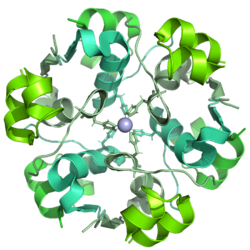Insulin glulisine
Topic: Chemistry
 From HandWiki - Reading time: 3 min
From HandWiki - Reading time: 3 min
 | |
| Clinical data | |
|---|---|
| Trade names | Apidra, Apidra SoloStar |
| AHFS/Drugs.com | Monograph |
| MedlinePlus | a607033 |
| License data |
|
| Pregnancy category | |
| Routes of administration | Subcutaneous, intravenous |
| ATC code | |
| Legal status | |
| Legal status | |
| Identifiers | |
| CAS Number | |
| DrugBank | |
| ChemSpider |
|
| UNII | |
| KEGG | |
| Chemical and physical data | |
| Formula | C258H384N64O78S6 |
| Molar mass | 5822.64 g·mol−1 |
| | |
Insulin glulisine is a rapid-acting modified form of medical insulin that differs from human insulin in that the amino acid asparagine at position B3 is replaced by lysine and the lysine in position B29 is replaced by glutamic acid.[4] It was developed by Sanofi-Aventis and approved for marketing by the FDA in 2004;[5] it is sold under the trade name Apidra.[6] When injected subcutaneously, it appears in the blood earlier than human insulin.[7] When used as a meal time insulin, the dose is to be administered within 15 minutes before or 20 minutes after starting a meal.[8] Intravenous injections may also be used for extreme hyperglycemia, but must be performed under the supervision of a medical professional.[2]
The most common side effects include hypoglycaemia (low blood glucose levels).[3]
Medical uses
Insulin glulisine is indicated for the treatment of diabetes mellitus.[3][2]
References
- ↑ 1.0 1.1 "Insulin glulisine Use During Pregnancy". 6 April 2020. https://www.drugs.com/pregnancy/insulin-glulisine.html.
- ↑ 2.0 2.1 2.2 "Apidra- insulin glulisine injection, solution Apidra SoloStar- insulin glulisine injection, solution". 6 December 2019. https://dailymed.nlm.nih.gov/dailymed/drugInfo.cfm?setid=e7af6a7a-8046-4fb4-9979-4ec4230b23aa.
- ↑ 3.0 3.1 3.2 "Apidra EPAR". https://www.ema.europa.eu/en/medicines/human/EPAR/apidra.
- ↑ "Apidra (insulin glulisine) injection, solution". DailyMed. http://dailymed.nlm.nih.gov/dailymed/archives/fdaDrugInfo.cfm?archiveid=7137.
- ↑ "Apidra FDA Approval History". https://www.drugs.com/history/apidra.html.
- ↑ (in de) Austria-Codex (2007/2008 ed.). Vienna: Österreichischer Apothekerverlag. 2007. ISBN 978-3-85200-181-4.
- ↑ "Insulin glulisine: a review of its use in the management of diabetes mellitus". Drugs 69 (8): 1035–57. May 2009. doi:10.2165/00003495-200969080-00006. PMID 19496630.
- ↑ "Insulin Glulisine". Drugs.com. https://www.drugs.com/monograph/insulin-glulisine.html.
External links
- "Insulin glulisine". Drug Information Portal. U.S. National Library of Medicine. https://druginfo.nlm.nih.gov/drugportal/name/insulin%20glulisine.
 |
 KSF
KSF